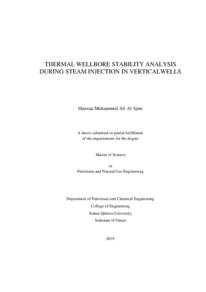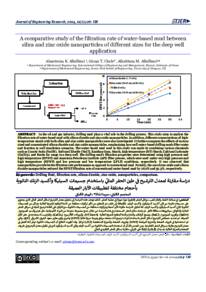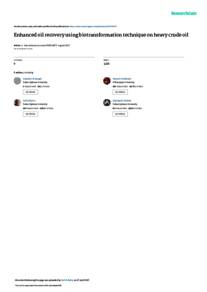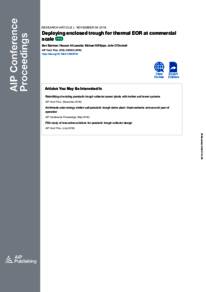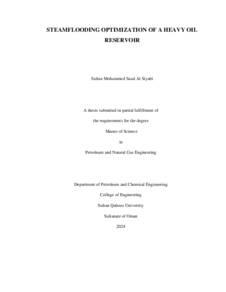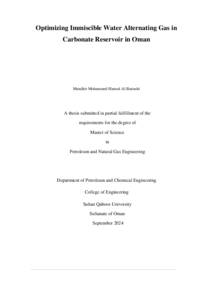Document
Thermal wellbore stability analysis during steam injection in vertical wells.
Publisher
Sultan Qaboos University.
Gregorian
2019
Language
English
English abstract
As production from mature fields is decreasing and new hydrocarbon discoveries are
not enough to match the growing energy demands, finding technologies to enhance
the hydrocarbons recovery plays essential rule in the oil and gas industry. Therefore,
enhanced oil recovery (EOR) particularly thermal EOR is becoming an essential
technique in global oil production. The thermal process involves injecting steam into
reservoir to heat the oil-bearing rocks and increase the production. Meanwhile, the
resulted temperature changes around the wells will change the rock mechanical state
of the reservoir and its surrounding. Therefore, the problem of wellbore instability
during the production will becomes more critical due to the introduction of thermal
stresses in the earth system.
The main objective of this study is to develop a new stability model that account for
the thermal effect, which is usually not considered as an input in most of the
conventional borehole stability models. The model predicts critical failure pressure
of vertical wellbores during production where the steam injection is adopted and it is
developed using "Mogi-Coulomb" failure criterion introduced by AL-Ajmi (2006).
Mathcad program was utilized to predict formation failure pressure (i.e. critical
bottom hole pressure) during steam injection. To verify the model, two Omani real
cases have been simulated. The model results have shown a good match with the
actual field observation. A sensitivity analysis was also conducted with typical
ranges of Omani oil fields. In the sensitivity analysis, the developed model was
compared with the conventional borehole stability model that neglects the thermal
stresses effect. The conventional model predicts a more stable borehole while the
developed model that a count for thermal stresses predicts a less stable scenario in
many cases. Accordingly, the results show that the application of heating leads to a
less stable formation in the production stage of the well.
The newly developed model in this study allows petroleum engineers to predict
formation failure pressure during steam injection. This will enhance early well
management, reducing time and cost. Furthermore, the optimal well design can be
established. Moreover, the developed model can be utilized for both steam flooding
and cyclic steam injection during production.
Member of
Resource URL
Arabic abstract
یعتبر الحقن بالبخار تقنیة أساسیة مستخدمة على نطاق واسع لتعزیز استخلاص النفط. تؤدي ھذه التقنیة الى مشكلة عدم استقرار حفرة البئر أثناء الإنتاج بسبب الضغوط الحراریة الناتجة. الھدف الرئیسي من ھذه الدراسة ھو تطویر نموذج ثبات استقراریھ جدید یأخذ في الاعتبار التأثیر الحراري. ویقوم النموذج َّ المطور بالتنبأ بضغط الفشل في الآبار العمودیة أثناء الإنتاج باستخدام قانون موجي-كولومب لتكسر الصخور. وقد تم التحقق من النموذج باستخدام دراستان میدانیتان لحقلین نفط في عمان. علاوة على ذلك، تم إجراء تحلیل للحساسیة بنطاقات نموذجیة لحقول النفط العمانیة. وأظھرت نتائج َّ یسمح تطبیق النموذج المطو الدراسة أن تطبیق الحقن بالبخار سیؤدي إلى إنخفاض كبیر في ثبات الآبار. و ر لمھندسي البترول بالتنبؤ بضغط فشل البئر لتعزیز إدارة الآبار المبكرة، وتقلیل الوقت والتكلفة. إضافة الى ذلك بالإمكان إستخدام النموذج المطور ً أیضا في تحدید التصمیم الأمثل للآبار.
Category
Theses and Dissertations

